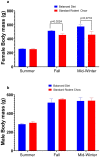Translating PUFA omega 6:3 ratios from wild to captive hibernators (Urocitellus parryii) enhances sex-dependent mass-gain without increasing physiological stress indicators
- PMID: 35503574
- PMCID: PMC9197884
- DOI: 10.1007/s00360-022-01437-6
Translating PUFA omega 6:3 ratios from wild to captive hibernators (Urocitellus parryii) enhances sex-dependent mass-gain without increasing physiological stress indicators
Abstract
Omega 3 polyunsaturated fatty acids (PUFAs) are well-documented for their influence on health and weight loss. Recent studies indicate omega 3 PUFAs may exert a negative impact on cellular stress and physiology in some hibernators. We asked if physiological stress indicators, lipid peroxidation and mass gain in Arctic Ground Squirrels (AGS) were negatively influenced by naturally occurring dietary omega 3 PUFA levels compared to omega 3 PUFA levels found in common laboratory diets. We found plasma fatty acid profiles of free-ranging AGS to be high in omega 3 PUFAs with balanced omega 6:3 ratios, while standard laboratory diets and plasma of captive AGS are high in omega 6 and low in omega 3 PUFAs with higher omega 6:3 ratios. Subsequently, we designed a diet to mimick free-range AGS omega 6:3 ratios in captive AGS. Groups of wild-caught juvenile AGS were either fed: (1) Mazuri Rodent Chow (Standard Rodent chow, 4.95 omega 6:3 ratio), or (2) balanced omega 6:3 chow (Balanced Diet, 1.38 omega 6:3). AGS fed the Balanced Diet had plasma omega 6:3 ratios that mimicked plasma profiles of wild AGS. Balanced Diet increased female body mass before hibernation, but did not influence levels of cortisol in plasma or levels of the lipid peroxidation product 4-HNE in brown adipose tissue. Overall, as the mass gain is critical during pre-hibernation for obligate hibernators, the results show that mimicking a fatty acid profile of wild AGS facilitates sex-dependent mass accumulation without increasing stress indicators.
Keywords: Ground squirrel; Hibernation; Omega 3; PUFA.
© 2022. The Author(s).
Conflict of interest statement
SR, MM and AK have no competing interests declared. KD has a financial interest in Be Cool Pharmaceutics and DB has a financial interest in Lipid Technologies, LLC.
Figures



Similar articles
-
Omega 3 fatty acids stimulate thermogenesis during torpor in the Arctic Ground Squirrel.Sci Rep. 2021 Jan 14;11(1):1340. doi: 10.1038/s41598-020-78763-8. Sci Rep. 2021. PMID: 33446684 Free PMC article.
-
Dietary fatty acid composition and the hibernation patterns in free-ranging arctic ground squirrels.Physiol Biochem Zool. 2008 Jul-Aug;81(4):486-95. doi: 10.1086/589107. Physiol Biochem Zool. 2008. PMID: 18513150
-
PUFA Changes in White Adipose Tissue during Hibernation in Common Hamsters.Physiol Biochem Zool. 2022 Nov-Dec;95(6):525-535. doi: 10.1086/721444. Physiol Biochem Zool. 2022. PMID: 36179357
-
Effects of polyunsaturated fatty acids on hibernation and torpor: a review and hypothesis.Am J Physiol Regul Integr Comp Physiol. 2008 Mar;294(3):R1044-52. doi: 10.1152/ajpregu.00688.2007. Epub 2008 Jan 2. Am J Physiol Regul Integr Comp Physiol. 2008. PMID: 18171691 Review.
-
Dietary Polyunsaturated Fatty Acids (PUFAs): Uses and Potential Health Benefits.Curr Nutr Rep. 2021 Sep;10(3):232-242. doi: 10.1007/s13668-021-00363-3. Epub 2021 Jul 13. Curr Nutr Rep. 2021. PMID: 34255301 Review.
Cited by
-
Pre-hibernation diet alters skeletal muscle relaxation kinetics, but not force development in torpid arctic ground squirrels.J Comp Physiol B. 2024 Feb;194(1):65-79. doi: 10.1007/s00360-023-01527-z. Epub 2024 Jan 14. J Comp Physiol B. 2024. PMID: 38219236 Free PMC article.
References
Publication types
MeSH terms
Substances
Grants and funding
LinkOut - more resources
Full Text Sources

